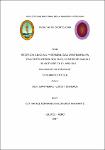| dc.contributor.advisor | Sologuren Anchante, Rafael Fernando | |
| dc.contributor.author | Florett Cisneros, Jean Pierre | |
| dc.date.accessioned | 2018-01-12T17:13:24Z | |
| dc.date.available | 2018-01-12T17:13:24Z | |
| dc.date.issued | 2017 | |
| dc.identifier.uri | http://repositorio.unapiquitos.edu.pe/handle/20.500.12737/5225 | |
| dc.description.abstract | El estudio, busca determinar la relación entre la recesión gingival y sensibilidad dentinaria en pacientes atendidos en el Centro de Salud “9 de octubre” en el año 2017.
De acuerdo al estudio estadístico se halló que el 51.9% de los pacientes presentan recesión gingival tipo I, seguido de tipo II con el 35.5% siendo en suma más del 50% del total de la población en estudio, teniendo como dato adicional el 11.3% y 1.2% de tipo III y IV, respectivamente, del mismo modo se encontró que el 58.2% del total de los mismos presenta sensibilidad moderada, seguido de un 28.1% sin sensibilidad dentinaria y un 13.7% con sensibilidad dentinaria extrema. Esto, sabiendo que en su mayoría es representada por aquellos con un rango de edad entre los 10 y los 29 años.
Por otro lado, se estudió la distribución de la muestra según índice térmico determinando que el 40.0% responde a estímulos del aire, pero no pide suspensión del estímulo contra un 29.3% que no responde a estímulos del aire, el 26.9% responde a estímulos del aire y pide la suspensión del estímulo mientras que el 3,9% responde a estímulos del aire y duele y pide la suspensión del estímulo.
En el grupo etáreo de10 a 19 años obtuvo el mayor porcentaje de recesión gingival del tipo I; de 20 a 29 y de 30 a 39 años el mayor porcentaje estuvo en el tipo II. Asimismo, en el rango de 40 a 49 años se encontraron mayor prevalencia en el grado III, por otro lado, en los grupos de 50 a 59 y 60 a más años se presentó mayor porcentaje del tipo III, y en menor cantidad del tipo IV.
Según la investigación se puede deducir que la recesión gingival es diferente según distintos grupos de edades, al igual que el índice táctil y térmico va diferenciándose según el grupo de edades en estudio. | es_PE |
| dc.description.abstract | The study seeks to determine the relationship between gingival recession and dental sensitivity in patients treated at the health center “9 de Octubre” in 2017.
According to the statistical study it found that 51.9% of patients treated present gingival recession type I followed by type II with 35.5% being more than 50% of the total population study, with the additional data 11.3% and 1.2% type III and IV, in the same way it was found that 58.2% of the same has moderate sensitivity followed by 28.1% without dentine sensitivity and 13.7% with extreme dentine sensitivity. This, mostly represented by those with an age range between 10 and 29 years.
On the other hand, it was studied, the distribution of the sample was studied by thermal index determining that 40.0% responds to stimuli air, but does not ask suspension stimulus against 29.3% unresponsive to stimuli of air, 26.9% responds to stimuli air suspension and requests stimulus while 3.9% responds to stimuli air and painful and asks the suspension stimulus.
In the age group 10-19 years had the highest percentage of gingival recession type I; from 20 to 29 and from 30 to 39 years old, the highest percentage was in type II. Also, in the range of 40 to 49 years, a higher prevalence was found in grade III, on the other hand, in the groups of 50 to 59 and 60 to more years there was a greater percentage of type III, and in a smaller amount of type IV.
According to the investigation it can be deduced that the recession is different according to different age groups, as the tactile and thermal index is differentiated according to the age group under study. | en_US |
| dc.description.uri | Tesis | es_PE |
| dc.format | application/pdf | es_PE |
| dc.language.iso | spa | es_PE |
| dc.publisher | Universidad de la Amazonía Peruana | es_PE |
| dc.rights | info:eu-repo/semantics/openAccess | es_PE |
| dc.rights | Attribution-NonCommercial-NoDerivs 3.0 United States | * |
| dc.rights.uri | http://creativecommons.org/licenses/by-nc-nd/3.0/us/ | * |
| dc.source | Universidad Nacional de la Amazonía Peruana | es_PE |
| dc.source | Repositorio institucional - UNAP | es_PE |
| dc.subject | Sensibilidad al dolor | es_PE |
| dc.subject | Recesión gingival | es_PE |
| dc.subject | Diente | es_PE |
| dc.title | Recesión gingival y sensibilidad dentinaria en pacientes atendidos en el centro de salud 9 de Octubre en el año 2017 | es_PE |
| dc.type | info:eu-repo/semantics/bachelorThesis | es_PE |
| thesis.degree.discipline | Odontología | es_PE |
| thesis.degree.grantor | Universidad Nacional de la Amazonía Peruana. Facultad de Odontología | es_PE |
| thesis.degree.level | Título Profesional | es_PE |
| thesis.degree.name | Cirujano Dentista | es_PE |
| thesis.degree.program | Regular | es_PE |
| dc.subject.ocde | http://purl.org/pe-repo/ocde/ford#3.02.14 | es_PE |


